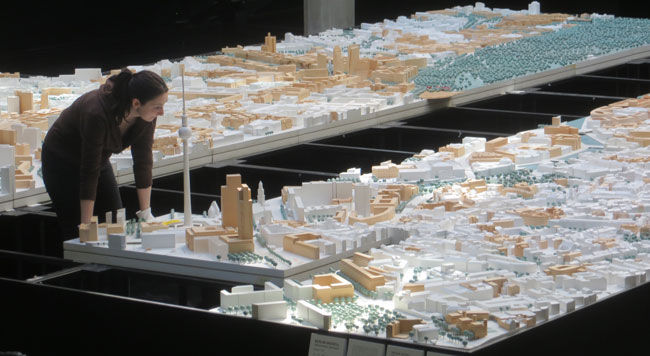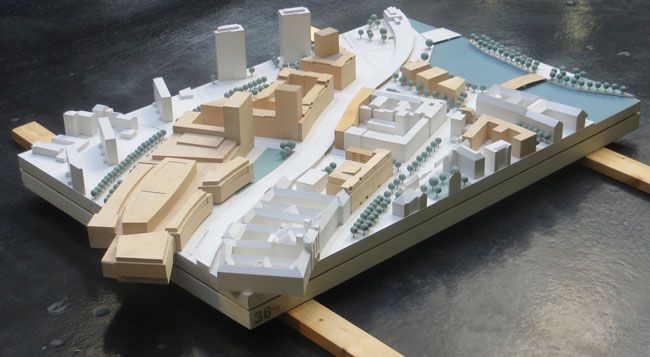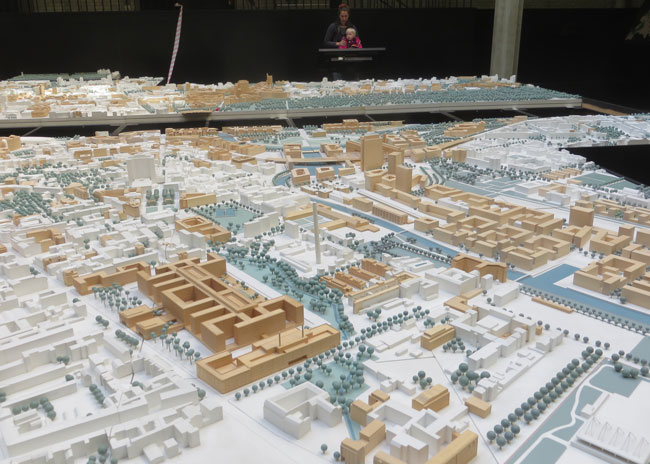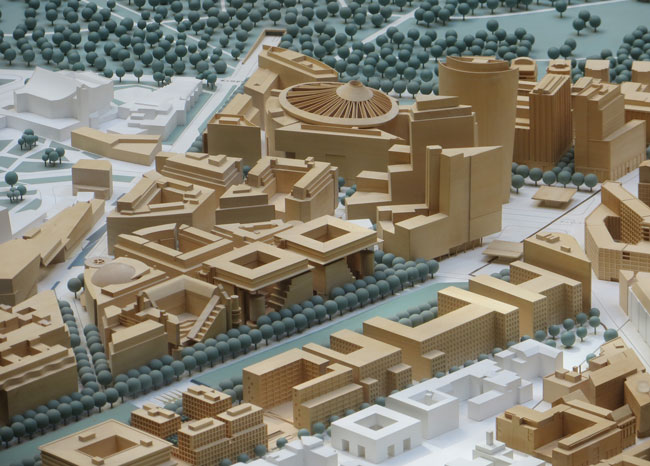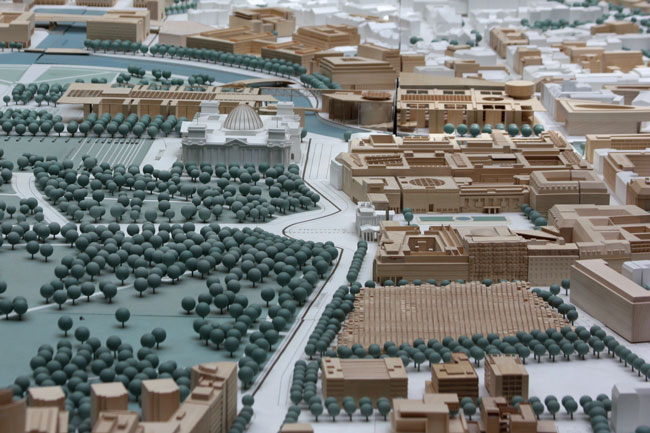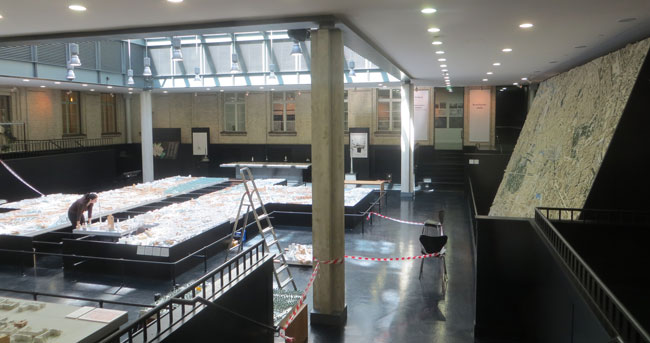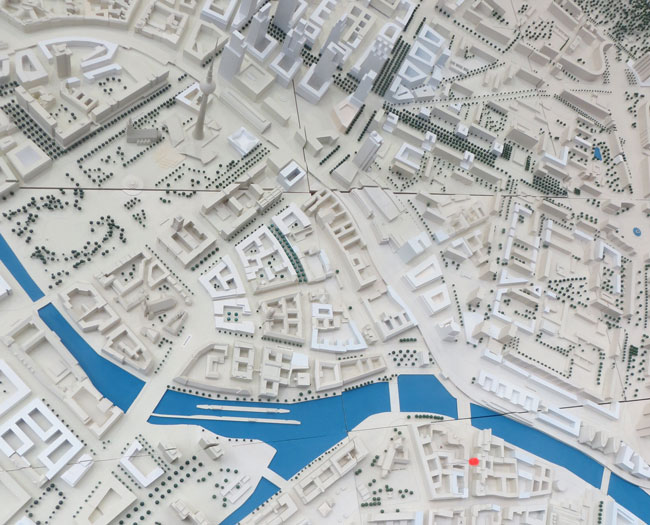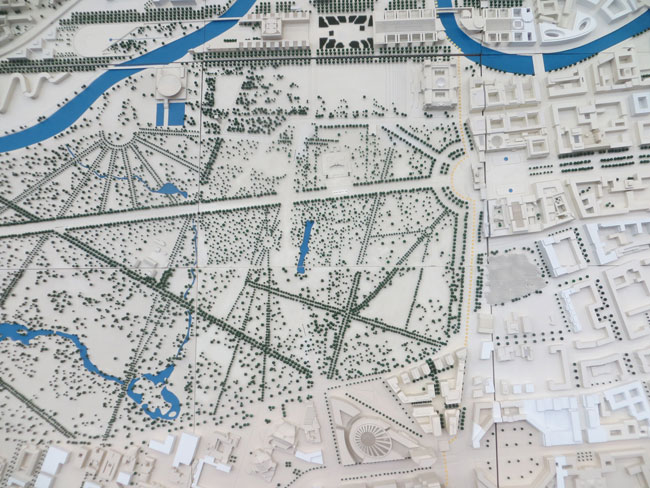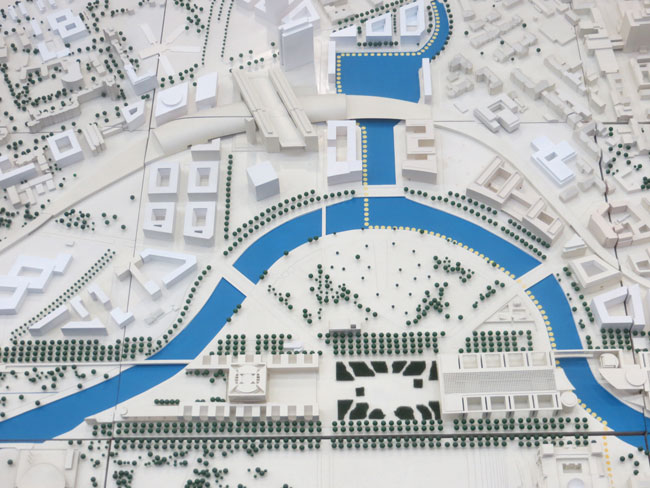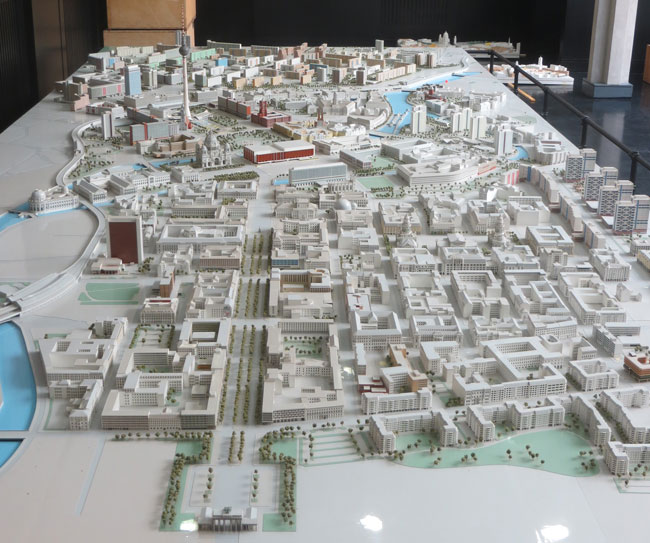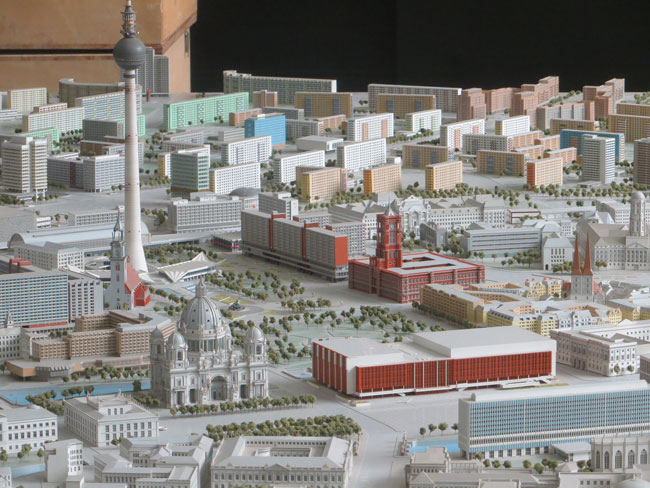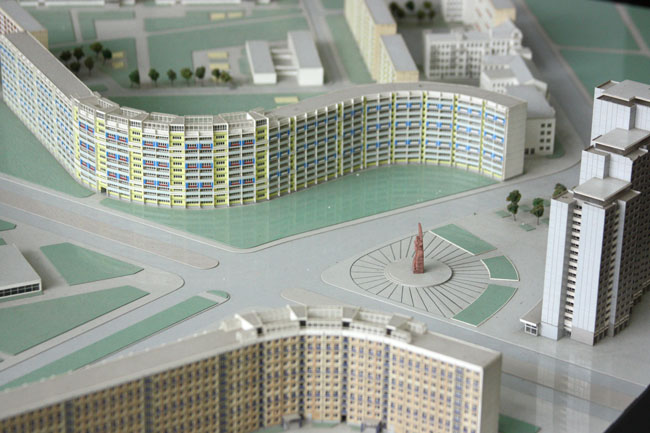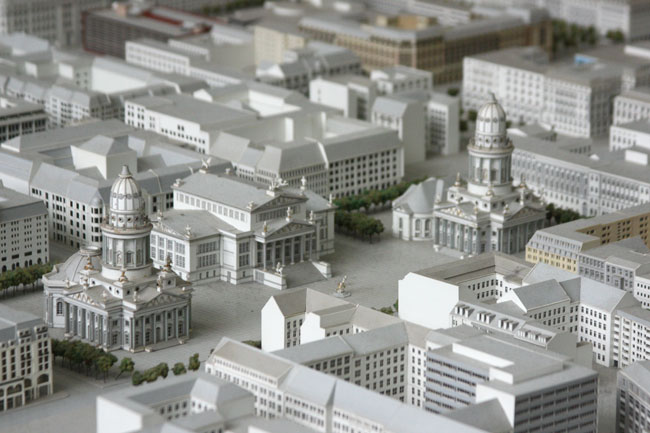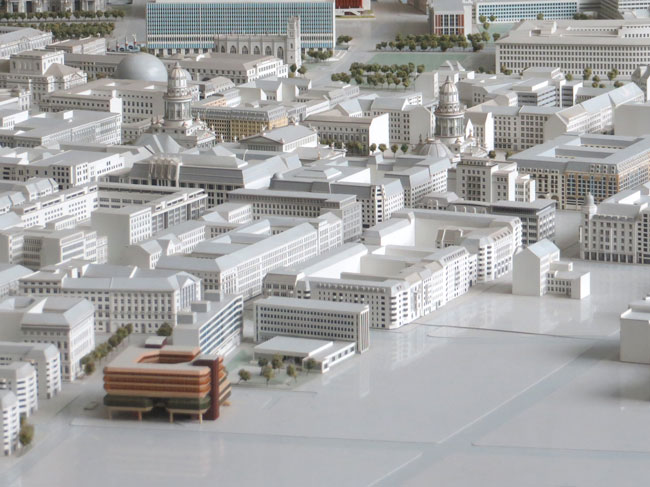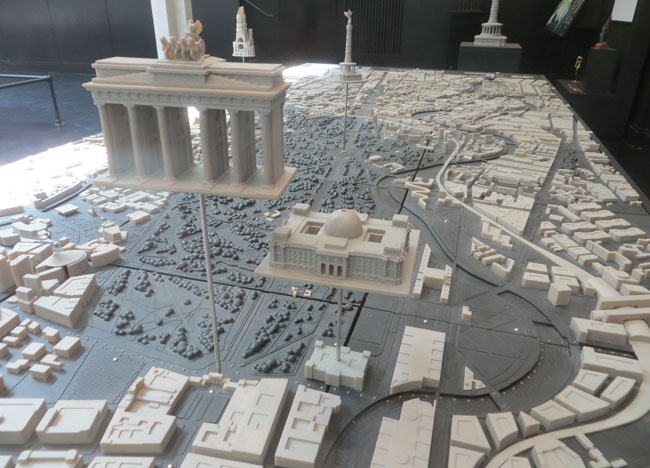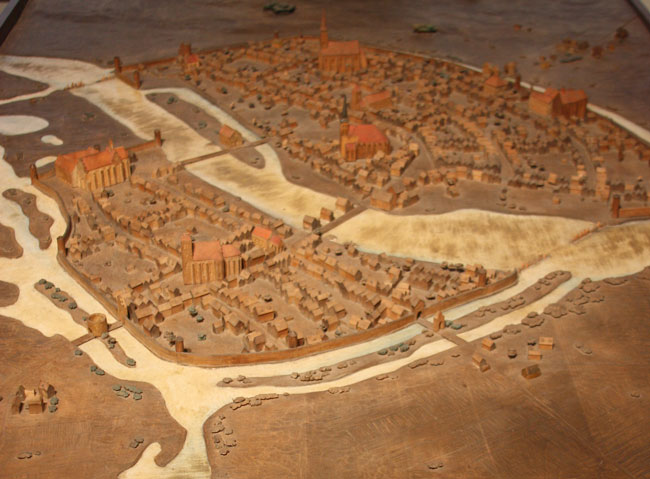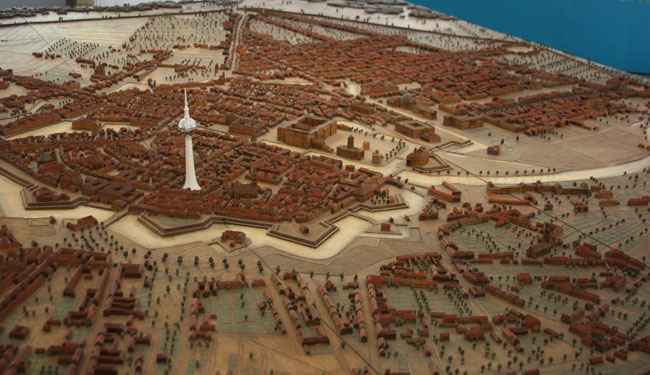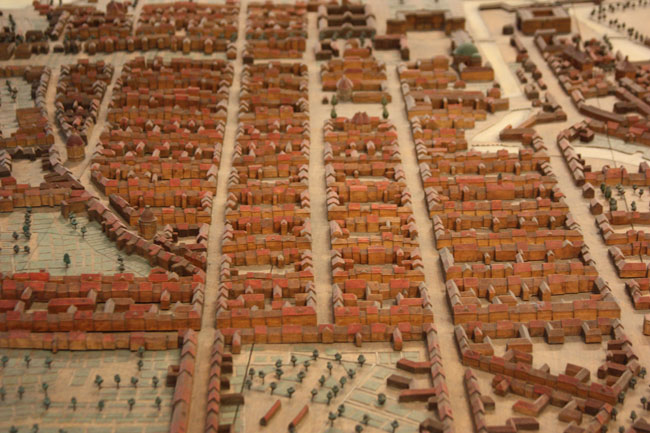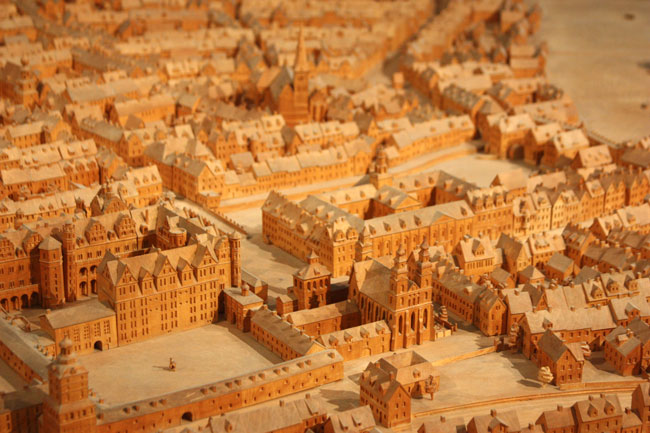|
The Berlin Senate Department for Urban Development and Housing features a permanent exhibition of the Berlin City Model. This 1:500 scale model of the historic center of Berlin was created in 1991 to assist in plans for the reunification of Berlin and rebuilding projects. The model has been updated to the current day. In this model, structures built before 1990 are painted white, while newer constructions are natural wood color.
The model sits in a sunlit atrium along with several other interesting models of Berlin. Small galleries to the sides of the atrium host temporary exhibits about new developments around the city.
On a visit in spring 2016, staff members had taken out the center sections of the model in order to photograph the middle buildings, which provided a glimpse at how the model was created. The closeup photographs of individual buildings of the model the staff are taking will be added to the Berlin Building Atlas, a fascinating online map viewer which cross-references historical maps, info, photos and building plans for several hundred structures in central Berlin. Visitors can also access the Building Atlas from an interactive display next to the model, which activates overhead lights to spotlight particular listings. The Building Atlas also offers free downloadable 2D maps and 3D data of a larger section of central Berlin than the model covers, which could conceivably allow anyone with a 3D printer (plus the time and the space) to build an even greater city model of Berlin!
The Berlin City Model is sectioned into 120 x 60 centimeter rectangles. The 67 sections amount to 48 square meters, or roughly 520 square feet. Compare this to the 1550 square-foot Moscow City Model or the vast Shanghai Urban Planning Model which are both built to the same model scale. The buildings appear to be made from painted wood blocks, true to the general shape of the structures but generally without windows or small details. The models of newer construction are made from unpainted linden wood and sometimes feature more complex details. As can be seen in the photo above, the larger buildings overlap the ends of the sections, rather than being split in half along the section lines. Parks and wider streets also feature rows of generic wooden trees which are simply a green wooden ball stuck on a dowel. A visiting toddler (my daughter) surreptiously uprooted one of the trees next to the Reichstag, but fortunately it was not difficult to replant the tree carefully in place.
The boundaries of the model contain only the center of the city, and are rather arbitrarily cut off at the edge of the rectangles that were deemed uninteresting for development purposes, rather than following natural or political boundaries. It would be interesting to see the model extended farther, to get a better appreciation of how the city neighborhoods relate to its center. The model is not quite large enough in scope to show the layout and growth of the entire city, but it is useful for examining the buildings of the central city.
Without too much detail, the modern buildings at Potsdamer Platz look like a chaotic postmodern jumble of toy blocks. In the 1990s after reunification, this long-abandoned site next to the Berlin Wall was the largest construction site in Europe. The circular tent roof of the Sony Center by Helmut Jahn can be seen above, and to its right the curved Daimler-Benz skyscraper by Renzo Piano, amid a mix of smaller buildings by other celebrity architects of the 90s.
A glimpse of the area around the Reichstag and Brandenburg Gate shows the careful craftsmanship of the model. All of the hundreds of stone pillars of the Holocaust Memorial are recreated with tiny blocks of linden wood. At the curve of the Spree river and connected by a bridge are the Federal government buildings completed in 2003.
Hanging on the wall behind the 1:500 scale model is another 1:1000 scale model of the Berlin which depicts planned developments in the city. The scale is smaller but the area is larger, giving a better overview of the city, though this model as well is not large enough to include all of Berlin's neighborhoods to the full extent of the city limits. The 1:1000 scale model is set up at an angle to make it easier to see the whole at a glance.
This model appears to be made of plastic and split in to sections which cut directly through numerous buildings. The lighter white buildings indicate planned construction. In each of the city models, a bright red plastic marker on a stick shows the location of the atrium gallery where the visitor is currently standing. At the top (north) of the photo, the Fernsehturm (TV Tower) is the focal point of the Alexanderplatz square built as the focal point of cold war East Berlin. To the northeast of the tower can be seen a forest of high-rise towers in development, the newest hot properties in Berlin waiting for the designs of today's celebrity architects.
The plain cream color of the model does not indicate parkland except by an abundance of miniature trees. Here the double rows of tiny trees betray the roadways and paths of the Tiergarten. A line of yellow dots indicates the former location of the Berlin Wall, from the front of the Reichstag at the bend of the river, south along the edge of the Tiergarten and past the Brandenburg Gate to the crossroads of Potsdamer Platz at the bottom of the photo.
North of the Reichstag are two of the major city building projects of the 2000s: the Chancellory and other linear government buildings which opened in 2001-2002, and the massive Hauptbahnhof (Central Station) which opened in 2006 connecting east-west elevated S-Bahn lines and long-distance trains with new underground rail tunnels running north-south under the river and the Tiergarten.
The minimalist color scheme helps show the city as a unified space, but I wish there were more colors or textures used to differentiate the streets and parks from the buildings. The structures float on a flat plane without landscaping or details that might indicate their entryways or relationship to one another. In the photo above, the subtle paths of the Lustgarten park in front of the domed Berlin Cathedral almost disappear into a blank area. The lack of density makes this area of the model seem uninteresting, when in fact this is the heart of historical Berlin. Across the street from the Lustgarten is the reconstruction of the City Palace, which had been the seat of Prussian imperial authority for 400 years, and later the site of the East German Palace of the Republic. Here the grand Unter den Linden boulevard crosses the Spree river and becomes Karl-Liebknect-Straße to the northeast. Just to the north of the Lustgarten are the various museums of the Museumsinsel, and to the east is the wide square of the Alexanderplatz. The imaginary miniature perambulist wandering these areas on the map might find them plain and dull, while in the real world the space is full of complexity, history, and details to ponder.
To the side of both models is a third city model which our imaginary miniature flaneur might prefer. This 1:500 scale model of East Berlin which was originally built as an urban-planning model for new construction in East Berlin in the mid 1960s. For many years after that it was on display in an information center at the Fernsehturm as a tourist attraction and showpiece of new architecture in the DDR. The model was built from plastic by Eberhard Bolte modelmakers of Leipzig and was kept current up until 1989. The original display featured lighting effects and a narrated audio tour, but now simply stands quietly in the gallery as a historic artifact.
Here the buildings are depicted in bright colors with plenty of detail to attract close viewing. Next to the ornate neoclassical Berlin Cathedral from 1906, we can see now-gone Palace of the Republic in brand new colors which was completed in 1976 on the site of the ruins of the City Palace. Across the river and past the pastel park landscaping of the Alexanderplatz is the red brick Rotes Rathaus (Red City Hall) completed in 1869. Beyond the square are the many tower blocks which are currently being replaced by new hi-rise skyscrapers as seen in earlier photos of the modern 1:500 scale model.
One area of tower blocks which has been preserved is the former Leninplatz (now United Nations Square) which opened in 1970 as a model of artistic socialist prefabricated housing. The "snake" block at the top and "boomerang" block at the bottom framed a 60-foot statue of Lenin carved from red granite, with the tall housing block to the right forming a stylized rippling flag backdrop. The ensemble was praised as a model of socialist urban planning, but the square lost its centerpiece when the Lenin monument was dismantled in 1991 after reunification, despite the objections of local residents. Pieces of the statue were buried in a sand pit, but Lenin's head was recently unearthed and is now on display at the Spandau Citatel.
A closeup of the Gendarmenmarkt shows the high level of detail of the model. The tiny Konzerthaus in the center even includes painted mullions on the tiny windows. Surrounding the square are the apartment and office blocks built in the nineteenth century popularly known as "Mietskaserne" which are typical of the areas surrounding the central city. These dense housing developments containing hundreds of apartments gave Berlin the highest population density in the Western world at the beginning of the twentieth century. The nickname means "rental barracks," which conveys a bit of the mixed feelings many then had about the tight quarters of the industrial city. After World War II, modernists scorned the courtyard apartments in favor of tower blocks surrounded by fresh air and healthful green space, but decades later the surviving Mietskaserne are again in demand as a quintessential Berlin building type.
The model has an interesting fade-out at its western boundaries. Of course the Wall around West Berlin is not depicted in the model which was meant to show off proudly the thriving city to tourists and citizens. Instead the houses simply stop at the edge of no-man's land, a sort of terra incognita where the streets continue but the city ends.
The only modern addition to the DDR Berlin model is a flourescent "You are here" marker showing the current location of the model. The red brick building across the street is the Märkisches Museum which contains several interesting city models as well.
Another unique city model in the gallery is a 1:2000 scale model of the city center which is meant to be touched. The plastic model was added to the gallery in 2013 to enable blind or sight-impaired visitors to understand the city. Several landmarks are magnified as more-detailed 1:300 and 1:100 scale models mounted on sticks above their locations, along with two stand-alone enlarged models nearby that can be touched. The model also features audio descriptions for over 150 locations on the map. Across the street at the Märkisches Museum, which concentrates on the history of Berlin, there are several notable miniature city models on the ground floor worth visiting to gain an understanding of Berlin's development.
Hundreds of years ago, the city grew from two small towns, Berlin and Cölln, which were located on opposite banks of the river Spree. This model was made from limewood by Walter Winkler and E. Prenzel in 1937 and depicts the twin towns in 1450. Cölln was located on Fisher Island in the foreground, with Berlin surrounded by a moat extending a little beyond where the TV tower now stands. The modern-day location of the Märkisches Museum is just out of the photo to the middle right.
Nearby is a larger 1:1000 scale wooden model by Winkler and Prenzel, also from 1937. This model depicts the city three hundred years later in 1750, growing rapidly to the west along Under den Linden boulevard, a row of linden trees planted in 1647 between the City Palace and the hunting grounds outside the city. At the far end of the model we see the road leading to the round plaza at Mehringplatz, then to the right the octagonal Potstamer Platz, and at the far right edge of the photo, the Brandenburg Gate, built in 1730. The wall around the west edge of the city was not a defensive wall, but a tax boundary where all goods entering or leaving the city must be inspected. Presumably in the 1970s some Märkisches Museum curator thought it helpful to add a doubly anachronistic model of the TV tower to help visitors understand "you are here".
The model contains a great number of little wooden "Monopoly houses," which are more generic space-filler than specific representation of the houses that stood here. Unter den Linden runs along the top of the photo. In 1691 King Friedrich I authorized a town to be founded here outside the old fortified city walls, with streets surveyed in a strikingly modern grid. Friedrichstadt grew rapidly in the early 18th century and was later absorbed by Berlin. These eighteenth-century wooden merchant houses were replaced by the nineteenth-century Mietskaserne shown in the East Berlin model closeup seen earlier.
The most impressive city model at the Märkisches Museum, however, is this 1:450 scale model depicting Berlin in about 1688, built by artist Armin Luda in 1970-71. The model was made for the Berlin Museum in West Berlin, whose collections were merged with the Märkisches Museum after reunification. The model depicts a city dominated by massive anti-cannon defensive walls and moats built in response to the trauma of the Thirty Years War. It is fascinating to walk back and forth to compare the three historic city models, to locate the same churches and other landmarks on each and see the changes to the city over time.
Here is an exquisite tiny world to fully absorb the tiny imaginary pedestrian! The three-dimensional sculpture is presumably based on seventeenth-century birds-eye-view maps, which could be more or less accurate in detail to the real city. Each little limewood house is beautifully carved with all the fascinating particulars of little windows, dormers and courtyards. If only all other city scale models were this charming! Further reading about Berlin's urban development: Ghosts of Berlin by Brian Ladd, University of Chicago Press (2011) Other visitors in search of miniature Berlin - Modellstadt/Stadtmodelle Berlin - Berlin als Modell Visit other mini cities around the world |









